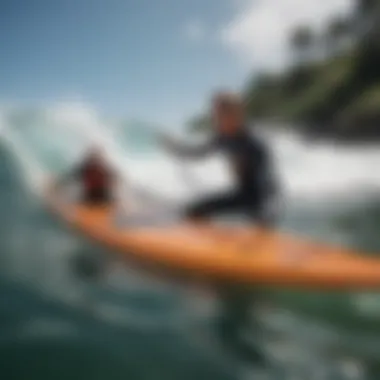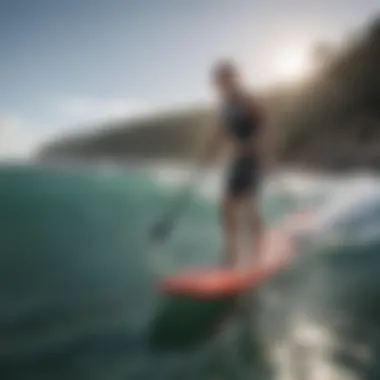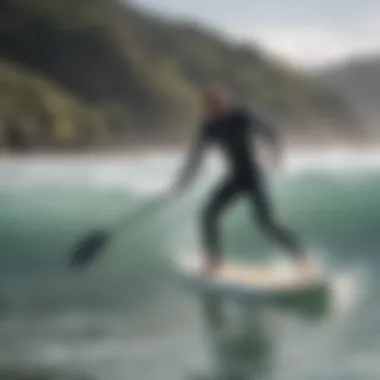Mastering Surf Technique with Paddle Trainers


Intro
In the expansive realm of surfing, where ocean swells beckon and tides change with the wind, paddle trainers emerge as unexpected allies in honing essential skills. These innovative tools don’t simply sit on the shelf collecting dust; they actively shape a surfer’s ability to navigate and dominate in the water. With each stroke refining technique, paddle trainers offer more than just physical engagement; they encapsulate the very essence of persistence and progress that defines surfing.
Not only do paddle trainers cater to seasoned surfers aiming to elevate their game, but they also provide beginners with a sturdy platform on which to build their foundation. The multiplicity of their benefits may sometimes get lost in the excitement of catching waves. By delving deeper into the intricacies of these tools, we can uncover their true potential in shaping surfing prowess.
As we journey through this guide, we will explore a variety of topics, including novel surf gear, optimal training practices, and time-tested techniques. Each section works synergistically to enhance the surfing experience, transforming daunting challenges into manageable practices. Let’s set sail into the sea of knowledge that is paddle training—where every lesson learned transforms the novice into the adept, and the adept into the master.
Surf Gear and Equipment
The world of surf gear can be just as dynamic as the waves themselves. Paddle trainers are part of a much larger conversation about surf equipment and its continual evolution. Understanding the gear that complements paddle trainers will give surfers a well-rounded view of their capabilities.
Latest Surfboard Technologies
With surfboards evolving at breakneck speed, it’s crucial to keep an eye on what’s hitting the shelves. Various materials—like epoxy and carbon fiber—now dominate, providing not only lighter boards but also superior flex and durability. Boards are also being tailored for specific wave types, making optimal performance more achievable.
"The right surfboard can be the difference between slicing through a wave or just catching air."
- Boards like the Firewire Dominator II cater to all levels, offering stability and responsiveness in diverse conditions.
- Brands like Lost Surfboards continue to push boundaries with high-performance designs that are responsive to rider input.
Essential Accessories for Surfers
Even with a perfect board, having the right accessories can elevate the surfing experience tremendously. Here’s a quick rundown of must-have accessories:
- Leashes: Preventing board loss is essential and varies in thickness depending on the wave height. A thicker leash is advisable for bigger swells.
- Wetsuits: Made from neoprene, these help surfers brave colder waters while maintaining flexibility. It’s essential to find the right fit for maximum comfort.
- Surf Wax: This simple yet effective tool prevents slipping, affording the surfer better grip on their board.
In summary, paddle trainers play a pivotal role not only in isolation but as part of a comprehensive approach to surfing. So, whether you’re an old salt or a greenhorn riding your first wave, remember that understanding your gear is half the battle.
Prelude to Paddle Trainers
In the ever-evolving world of surfing, paddle trainers have emerged as a vital tool for surfers at all levels seeking to boost their performance. They exist not just as a piece of equipment but also as a bridge between effort and skill. These trainers allow for the refinement of paddling techniques, which is fundamental since paddling is, without a doubt, the backbone of maneuverability and endurance on the wave.
Defining Paddle Trainers
Paddle trainers are specially designed devices that simulate the paddling motion necessary for surfing. They can come in various forms, from stationary setups that mimic strokes in a controlled environment, to portable models that surfers can take to the beach. These trainers often feature adjustable resistance levels, allowing users to tailor their workout intensity to their personal fitness and skill level.
The goal of paddle trainers is straightforward: enhance the surfer's paddling efficacy by promoting muscle memory and proper technique. When engaging with these trainers, surfers can learn to maintain a rhythmic and efficient stroke pattern, which is essential when catching waves or traversing through surf breaks.
Purpose and Importance
The importance of paddle trainers is underscored when considering the demands of surfing. First and foremost, they help in building endurance. Paddleboarding or surfing typically requires considerable stamina, and regular training with a paddle trainer allows one to increase their time in the water without prematurely exhausting themselves.
Beyond mere physicality, paddle trainers provide an opportunity for surfers to hone their technique. By practicing in a controlled setting, surfers can focus on their body position and stroke efficiency without the distractions of ocean conditions. This practice can lead to significant improvements by helping surfers become cleaner and faster in their paddling.
"Paddle trainers empower surfers to break through the barriers of the waves and harness their true potential."
Additionally, as surf conditions can be unpredictable, being prepared through consistent paddle training enhances adaptability. Surfers can train for various conditions without having to rely exclusively on ocean access. This is particularly beneficial for those living in locations where the waves are not always favorable for practice.
The Mechanics of Paddle Training
Paddle training is essential for honing surfing skills. It forms the foundation of a surfer's ability to maneuver on the water. Understanding the mechanics of paddle training can bridge the gap between novice surfers and those who are striving to refine their technique. Gaining insight into this aspect allows surfers to elevate their performance, tackle different surf conditions, and enhance their overall gameplay.
Understanding Paddling Techniques
Mastering paddling techniques involves more than just moving arms in water. Each stroke is pivotal for generating the momentum needed to catch waves and navigate through currents. Key elements of effective paddling include:
- Body Position: Keeping your body balanced and aligned is paramount. A flat body position minimizes drag, enabling smoother gliding.
- Stroke Technique: Each stroke should engage both the arms and core. Using your core muscle effectively will not only enhance performance but also reduce fatigue over time.
- Breathing: Breathing might seem trivial, yet it impacts endurance. Controlled breathing helps maintain stamina, allowing sessions to last longer without exhausting.
Surfers often practice these techniques on paddle trainers to simulate the physical demands of surfing. The aim is to develop muscle memory that translates directly onto the waves.
Biomechanics of Paddling
The biomechanics of paddling reveal the intricate relationships between body movements and muscular engagement. Knowing how your body behaves in water can lead to optimized performance.
- Force Application: Understanding how and when to apply force during a paddle stroke impacts propulsion. This aligns the rush of energy and momentum effectively.
- Joint Mechanics: The joints, especially the shoulders and wrists, undergo strain. Familiarity with joint movements allows surfers to place less stress on them, reducing injury risks.
- Muscle Activation: Different paddling exercises target various muscles, including the back, arms, and core. Engaging these muscles effectively is crucial for achieving power with each stroke.
"In surfing, the paddle is not just a tool; it is an extension of the body, necessitating harmony between biomechanics and technique."
By dissecting these components, surfers can better appreciate the science behind paddling. Investing time in understanding these mechanics will result in improved efficiency and effectiveness on the water. The insights gathered from paddle training exercises can make a significant difference in creating proficient surfers, ready to tackle varied wave conditions confidently.
Advantages of Using Paddle Trainers
Paddle trainers are gaining traction within the surfing community, acting like a secret weapon for surfers who want to up their game in the water. These tools are not just toys; the advantages they offer are manifold and significant. By focusing on specific areas such as core strength, endurance, and technique refinement, paddle trainers can help surfers harness their full potential and navigate the waves with grace and power. Let's delve deeper into these benefits.
Improving Core Strength
Core strength is at the heart of effective surfing. Every paddle stroke requires a stable core to maintain balance on the board. When using a paddle trainer, surfers engage their abdominal muscles, back muscles, and even hip flexors with each movement. This engagement mimics the paddling motion in the water, allowing surfers to build muscle definition that translates directly onto the waves.
- Why Core Strength Matters:
- It supports better stability on the board.
- A strong core aids in generating power for strokes, leading to faster paddling.
- Core muscles also help in preventing injuries, as a stable core can mitigate the strain on the back and hips during long surf sessions.


Incorporating specific drills with paddle trainers can amplify these benefits. Consider adding rotation-focused exercises that directly target your oblique muscles while maintaining a paddling position. This approach not only helps in building core strength but also improves overall balance, which is crucial for executing sharp maneuvers on a surfboard.
Enhancing Endurance
When it comes to catching waves, endurance is just as vital as technique. Paddle training increases cardiovascular fitness, helping surfers sustain longer sessions without fatigue. It's simple: the more time you can spend in the water, the better your skills will become. Paddle trainers simulate the rigorous paddling movements needed to navigate currents and waves, giving surfers the endurance needed to stay competitive.
- Endurance Training Benefits:
- Increases lung capacity, allowing for deeper breaths while exerting energy.
- Boosts stamina, reducing overall fatigue which can lead to more consistent performance.
- Enhances recovery time, enabling surfers to bounce back quicker after strenuous paddling sessions.
To maximize endurance, try incorporating interval training with your paddle trainer. Alternate between intense bursts of effort and periods of lower intensity. This method closely mirrors the dynamic nature of surfing, where surfers often paddle hard to catch a wave and rest in between.
Refining Technique
Technique can make or break a surfer’s success, and paddle trainers provide a controlled environment where skills can be honed without the unpredictability of the ocean. Surfers can focus on their paddle stroke mechanics, hand placement, and timing, which are crucial elements in achieving speed and efficiency on the water.
- Key Technique Areas to Focus On:
- Angle of the Paddle: Ensuring the paddle enters the water at the optimal angle can enhance stroke effectiveness.
- Grip and Hand Positioning: A proper grip enables better control, making strokes more effective and fluid.
- Timing and Rhythm: Paddle trainers help develop muscle memory, enabling surfers to replicate efficient movements under real-world conditions.
As surfers practice, subtle adjustments can be made in form, allowing for personalized improvements. Feedback on form can often come from watching yourself in a mirror while training, giving clarity to areas needing adjustment.
"Paddle trainers not only build muscle, they fine-tune the surfer's technique—a dual benefit that repays its investment many times over."
In summary, paddle trainers open a door to a more refined surfing experience by focusing on core strength, amplifying endurance, and enhancing paddling techniques. Integrating these elements into regular training can yield significant improvements on the waves, pushing surfers closer to their personal bests.
Types of Paddle Trainers Available
When it comes to paddle training, having the right tools can make all the difference. Paddle trainers play a crucial role in helping surfers fine-tune their technique and build necessary strength. In this section, we'll explore the various types of paddle trainers available, highlighting their unique features and benefits to help surfers choose the one that best fits their training needs.
Stationary Paddle Trainers
Stationary paddle trainers are the backbone for many dedicated surfers. These devices allow users to practice their paddling technique without the need for water. Some are designed with flotation devices that mimic the resistance of actual water, giving surfers an authentic feel of paddling.
One of the main advantages of stationary trainers is the stability they provide. By fixing the trainer in place, you eliminate the unpredictability of ocean currents and waves. This controlled environment allows for focused practice, which is essential for mastering proper hand placement and stroke techniques. It's like having the perfect wave at your backyard, day in and day out.
Additionally, stationary paddle trainers often come equipped with adjustable resistance settings, allowing surfers to gradually increase difficulty as their skills improve. Investing in a quality stationary paddle trainer can lead to significant technical advancements and improved performance out on the waves.
Portable Paddle Trainers
Portable paddle trainers are a convenient option for surfers who wish to train on-the-go. These trainers are typically lightweight and easy to transport, making them ideal for beach trips or even traveling abroad. Think of them as the Swiss army knife of paddle training; they provide various training options without weighing you down.
Using a portable trainer allows surfers to practice anywhere, be it the beach, a park, or even their backyard pool. Many models come with inflatable components or collapsible designs that make them easy to set up and take down. This flexibility can foster consistency in training, as surfers might find themselves practicing more often simply due to the convenience of having the equipment readily available.
Furthermore, portable trainers can simulate different paddling scenarios, which enhances a surfer's adaptability. Whether it's practicing powerful strokes or refining your endurance in short bursts, these versatile tools can help in shifting your skills to the next level.
Custom Paddle Trainers
For those who are serious about their surf training, custom paddle trainers offer a tailored solution to meet individual needs. These trainers can be specifically designed to mirror a surfer's unique paddling style or address particular weaknesses in their technique. Customization options may include varied resistance levels, dimensions, and even materials that suit different preferences.
Investing in a custom paddle trainer shows a commitment to embracing the sport seriously. Having equipment tailored to one’s own style can expedite the learning process. Surfers will get to work on precise areas that need improvements, thus maximizing their practice sessions. Also, if you're often competing, having a personalized tool can help you develop strategies that fit your performance goals.
Although custom trainers may come with a higher price tag, the return on investment can be significant when you consider the progression in your skills over time. In a sport that relies heavily on technique and efficiency, a customized trainer can truly give you the edge you need.
"Choosing the right paddle trainer is like picking the right board — it has to fit you perfectly to enable the best performance."
How to Integrate Paddle Training into Your Routine
Integrating paddle training into your routine can be the secret sauce that elevates your surfing game. It's not just about hopping on a board and battling waves; it requires a thoughtful approach to enhance skills and performance. The key is to understand where paddle training fits into your life and how it can be tailored to your unique needs.
Assessing Current Skills
Before diving headfirst into paddle training, it's crucial to evaluate your current abilities. Take a moment to reflect: How confident do you feel when you paddle out? Are you battling fatigue after just a few minutes? Recognizing your strengths and weaknesses will guide your approach moving forward.
Pro tip: Record a video of yourself while paddling. This gives you a visual reference to pinpoint areas for improvement. Once you’ve identified the gaps, such as timing, strength, or technique, it makes setting realistic and achievable goals much simpler.
Setting Goals
With your self-assessment in tow, it’s time to set some goals. Aim to make these objectives specific, measurable, attainable, relevant, and time-bound— the classic SMART criteria. For instance, instead of saying, "I want to paddle faster," try something like, "I want to improve my paddling speed by 10% in three months by training twice a week on the paddle trainer."
Here are a few examples of goals you might consider:
- Endurance: Increasing the duration you can paddle without tiring.
- Technique: Focusing on your strokes' efficiency.
- Strength: Building core and upper body strength through targeted exercises.
Having well-defined goals acts as a compass that keeps you aligned on your paddle training journey.
Creating a Training Schedule
Once you have goals, the next step is crafting a training schedule that suits your lifestyle. Consistency is key; even just a few hours a week can lead to significant improvements. Here are some tips to create your training schedule:
- Assess Availability: Identify the times during your week when you can dedicate to training without distractions.
- Balance Intensity: Alternate between high-intensity workouts and recovery sessions to avoid burnout and injuries.
- Make it Varied: Mix up your workouts on the paddle trainer with supplementary exercises, like strength training and flexibility work.


Include rest days in your schedule; they are essential for recovery and muscle building.
To wrap it up, integrating paddle training into your routine doesn’t have to feel overwhelming. It’s about striking a balance, assessing skills, setting goals, and making a manageable training plan. Remember, even small tweaks can lead to significant gains in your surfing prowess.
"Success isn’t just about what you accomplish in your life, it’s about what you inspire others to do." This rings true in paddle training. Aim to share your insights with fellow surfers!
With time, focus, and a well-tailored approach, you’ll be on your way to mastering the waves with skill and confidence.
Best Practices for Using Paddle Trainers
Using paddle trainers effectively contributes significantly to improving surfing skills. By understanding how to maximize the potential of these tools, surfers can experience noticeable enhancements in their performance and enjoyment. This section looks at some best practices for using paddle trainers, focusing on key elements such as form, drills, and tracking progress.
Focus on Form
The foundation of effective paddling lies in maintaining proper form, and this is even truer when using paddle trainers. When you’re training, the way you position your body, arms, and even your head matters deeply. A proper stance allows for better propulsion through the water and can prevent injuries down the line.
To maintain optimal technique:
- Alignment: Keep your body straight and align your head with your spine. Think of it as being pulled by an invisible string from the crown of your head towards the sky.
- Grip and Stroke: Your grip on the paddle should be firm but not tense. Ensure that your stroke mimics the natural paddling motion, allowing for a smooth entry into the water every time.
- Breathing: Pay attention to your breathing pattern. Deep, controlled breaths can help maintain a steady rhythm, which is crucial in the water.
Overall, staying mindful of form during paddle training results in a better transfer of skills when hitting the waves.
Incorporating Drills
Integrating specific drills into your paddle training routine can significantly enhance technique and build muscle memory. Drills should be aimed at addressing particular aspects of paddling, such as strength, speed, or endurance. Here are some to consider:
- Endurance Drills: Practicing continuous paddling for intervals, say 15 to 20 minutes, helps build stamina. Tackling such drills can prepare your body for long outings on the ocean.
- Speed Drills: Focus on rapid, powerful strokes for short bursts. This type of training can teach you how to quicken your speed when catching a wave.
- Technique Drills: Set up a mirror or video your paddling to assess your form and make necessary adjustments. This feedback loop is invaluable.
By varying the drills, you maintain engagement in your training and make substantial progress across different skills.
Tracking Progress
To really understand where you're improving, tracking your progress is crucial. Without clear targets or benchmarks, there are chances of plateauing or losing focus.
Here are some tips on how to keep an eye on your development:
- Session Logs: Maintain a journal noting down your paddle sessions—duration, types of drills, and notes on technique. This helps identify patterns over time.
- Use Technology: Fitness apps or wearable tech can help monitor heart rates, paddling speed, and even calorie burn during training. It's a great way to gauge fitness improvements over time.
- Video Analysis: Recording your sessions can provide visual feedback which verbal instruction simply cannot convey. It can be eye-opening to see your form on camera.
Regularly reflecting on these metrics can keep you motivated and reveal areas ripe for further development.
"Success in surfing, like in life, is often determined by the effort you put in behind the scenes."
Through these outlined best practices, combining focus on form, effective drills, and diligent progress tracking can result in significant enhancements in paddling skills, setting the stage for success in the waves.
Common Misconceptions About Paddle Trainers
In the realm of surfing, paddle trainers have become increasingly popular among enthusiasts seeking to enhance their performance. However, despite their growing presence, several misconceptions persist that can shape opinions and behaviors concerning their use. Ignoring these misunderstandings can prevent surfers from fully benefiting from what paddle trainers have to offer. By shining a light on the common myths, we aim to clarify their functionality and significance in surf training.
Not Just for Beginners
One of the most prevalent misconceptions is that paddle trainers are exclusively for novice surfers. This idea couldn't be further from the truth. While it’s true that beginners can significantly benefit from using paddle trainers to master balance and basic paddling techniques, experienced surfers also find value in them.
Professional surfers often face unique challenges that require fine-tuning of specific skills. A seasoned surfer looking to perfect their stroke efficiency or improve power in their paddling can use paddle trainers to simulate varied conditions without the unpredictability of the ocean.
Consider this: an advanced surfer preparing for competition can simulate a specific wave pattern or refine their response to varied surf conditions using a paddle trainer. It's all about adapting the tool to further develop skills, rather than just learning the basics. Paddle trainers can be tailored not just for foundational learning but also for complex skill enhancement.
"Every surfer, regardless of level, has room for refinement. What you practice matters just as much as how you practice it."
Paddle Trainers are Complementary Tools
Another common misconception is that paddle trainers can replace actual in-water practice. While paddle training is invaluable, it serves as a complement to traditional surfing rather than a stand-alone solution. The ocean offers elements such as current, wave dynamics, and environmental factors that no simulator can replicate entirely.
Paddle trainers facilitate controlled practice, allowing surfers to focus on specific skills without distraction. Using these tools can drastically improve technique, muscle memory, and endurance. However, to truly master the art of surfing, one must still engage with real surf conditions. Balancing paddle training with in-water experiences enhances the learning curve.
Advantages of Complementary Training Approach:
- Skill Transfer: Skills learned on a paddle trainer often transfer effectively when surfers hit the waves.
- Confidence Building: Surfers can practice fearing no wipeout or losing balance, thus building confidence for the actual water experience.
- Custom Practice: Surfers can focus on specific techniques that need improvement — this tailor-made training approach leads to a more effective learning process.
By understanding these misconceptions, surfers can utilize paddle trainers more effectively, ensuring they are seen as tools to enhance their craft rather than crutches.
Case Studies: Success Stories with Paddle Training
The narrative surrounding paddle trainers extends beyond mere technique and exercise; it’s an evolving tapestry woven into the fabric of surfing culture. The significance of examining success stories—both of novice and seasoned surfers—lies in the insights these individual experiences provide. Through their journeys, we learn that paddle trainers are not merely tools, but instruments that can lead to transformative changes in skill set and approach to surfing.
These stories resonate because they highlight real-life applications of paddle training methods and show how different surfers adapt. From learning to paddle efficiently to mastering the complex art of timing and wave selection, each success story offers a glimpse into the myriad benefits that paddle trainers can bring.
Beginner Surfers’ Perspectives
For many learners, the allure of surfing can feel overwhelming. But paddle trainers have emerged as a game changer. Beginners have noted the way these tools help them develop foundational skills without the pressure of catching waves. This shift in focus creates a safer and more controlled environment.
Key Takeaways from Beginner Experiences:


- Boosting Confidence: Many report feeling more self-assured after spending time with paddle trainers, as they can focus on improving their paddling without the anxiety of falling off the board.
- Understanding Body Mechanics: Beginners can grasp the basic muscle movements needed for effective paddling.
- Fostering Technique Over Instinct: They learn to prioritize technique, knowing that it can make a significant difference in the water.
One beginner in California recounted how paddle training not only improved their speed but also shifted the way they approached the ocean. They said, "Before paddle training, I was all over the place. Now, I feel more in control, like I can actually tackle the waves instead of just hoping for the best."
Professional Surfers Using Paddle Trainers
On the other side of the spectrum, professional surfers have taken note of paddle trainers as well. In their world, refining technique can be the difference between podium finishes and personal bests. The successful integration of these tools into their routines illustrates their versatility across skill levels.
Insights from Professionals:
- Fine-tuning Skills: For seasoned surfers, paddle trainers allow them to isolate technical aspects of their stroke. This practice leads to improved efficiency in the water, crucial when competing in challenging conditions.
- Conditioning and Endurance: Pro surfers utilize paddle trainers not just for skill refinement, but to boost their overall paddling endurance, which is critical during long heats.
- Injury Prevention: Many athletes recognized that a stronger core, developed through paddle training, helps mitigate the risk of injuries that can arise from intensive training sessions.
A notable figure in the surfing community shared, "Paddle trainers have become part of my everyday training routine. They’re not just an option; they're a necessity. I’ve seen marked improvements in my performance and stamina, especially in competitions."
"The perfect wave often stems from perfect preparation."
Each of these case studies serves as a reminder that paddle trainers play a diverse role in the surfing world. They offer valuable lessons in persistence, dedication, and the quest for improvement—principles that resonate deeply among surfers of all levels. From the first hesitant strokes of a novice to the precise movements of a professional, the path is enriched by the lessons learned through paddle training.
Paddle Training and Surfing Conditions
Understanding the relationship between paddle training and different surfing conditions is crucial for any surfer aiming to elevate their skills. This section delves into how paddle trainers can effectively prepare surfers to adapt to a variety of challenges presented by changing surf environments and competitive scenarios.
Adapting to Varying Surf Environments
Surfing doesn't come with a one-size-fits-all approach. Every wave has its own temperament, and diversifying your paddle training can ensure that you’re not caught off guard when facing unexpected conditions.
By using paddle trainers, surfers can mimic the dynamics of diverse surf environments, thus developing a more adaptive technique. Take, for instance, the difference between paddling in small, choppy waves versus larger swells. The former demands quick bursts of energy and agility, while the latter requires sustained power and endurance. Engaging in specific drills on a paddle trainer can simulate these varying demands.
Some effective strategies include:
- Varying Resistance: Adjust the settings on your paddle trainer to target different paddling power for both waves.
- Incorporating Directional Drills: Practice angling your strokes to simulate wind conditions that may cause surf to break unpredictably.
- Endurance Sessions: Focus on long periods of paddling to build stamina for those days when you find yourself battling through rougher waters.
Ultimately, developing a well-rounded approach to your training not only hones your physical abilities but also sharpens your mental readiness for any surfing scenario.
Preparing for Competition
As competition season approaches, many surfers stress over how well they will perform against others who have the same passion for the sport. Paddle training becomes a priceless ally in this arena. It allows surfers to refine their skills in a control environment, perfecting their technique and enhancing their overall performance prior to competition day.
Here are a few aspects athletes should focus on when integrating paddle training into their competitive preparation:
- Mimicking Competition Conditions: Use a paddle trainer to replicate the exact conditions you’ll face. This means adjusting not only resistance but also incorporating timing drills to practice cadences that match those of your competitors.
- Focused Technique Work: Dial in on the key components of your paddle strokes—ensure that your form is consistent and efficient to translate into the real surf environment.
- Mental Conditioning: Incorporate visualization techniques. Picture yourself winning that heat, preparing not only your body but also your mind. Paddle training allows you to associations muscle memory with competitive scenarios.
As you gear up for competition, it’s not just about physical prowess; the mental game is equally critical. Make paddle training a staple of your routine to stay ahead of the game.
"Success doesn’t come from what you do occasionally; it comes from what you do consistently."
By dedicating yourself to mastering paddle training, you’re not merely preparing for the surf; you’re preparing to conquer it.
The Future of Paddle Training in Surfing
Paddle training is at a crossroads, where tradition meets innovation. As surfers increasingly seek ways to enhance their skills, paddle trainers have emerged as a crucial element in this evolution. The importance of understanding how paddle training will change in the future cannot be understated. With constant improvements in design and technology, surfers can better simulate real-life conditions on land before hitting the waves. This blend of old-school paddling techniques and new-age training tools can bring a whole new level of efficiency in honing surf skills.
The coming years promise a host of advancements that will benefit surfers of all levels. New designs may not only focus on improving strength but can also enhance technical skills, making paddle training a robust part of every surfer’s practice routine.
Innovations in Design
When it comes to paddle trainers, innovation is the name of the game. Advances in both materials and shapes are paving the way for training devices that cater more specifically to the needs of surfers. For example, manufacturers are exploring lightweight, durable materials that allow for easier transport yet maintain structural integrity under stress. Additionally, customization is becoming more common. Surfers can choose paddle trainers that are specifically tailored to their body type and skill level. This personalization can lead to enhanced training effectiveness and greater user satisfaction.
Moreover, the integration of ergonomic designs ensures user comfort during long practice sessions. New models might incorporate features like adjustable resistance levels, allowing surfers to effectively challenge themselves as they improve.
Influence of Technology on Training Methods
The interplay between technology and paddle training is transformative. With the rise of smart devices, surfers can now access training applications that utilize data and analytics to create a more personalized training experience. This could include wearable technology that monitors heart rate and calories burned while practicing with a paddle trainer.
Furthermore, virtual reality is starting to play a role. Imagine donning a VR headset that immerses you in a simulated surf environment right in your living room or garage, while a paddle trainer helps you build the necessary strength and technique to excel in the water. The synergy between virtual simulations and physical training is not just an exciting idea; it's a developing reality.
"The combination of innovative design and technology in paddle training is likely what will keep surfers ahead of the curve, enabling them to adapt effortlessly to varying surf conditions."
Incorporating augmented reality for live feedback during training is another frontier being explored. This could provide surfers with real-time analysis of their paddling technique, helping them to immediately adjust their form to maximize efficiency and power.
In summary, the future of paddle training in surfing is ripe with promise. With evolving designs and technology, surfers can expect a tailored, data-driven approach that caters specifically to their needs. Embracing these advancements can solidify paddle training’s essential role in equipping surfers with the skills necessary for mastering the waves.
Finale
Understanding paddle trainers taps into the essential gears of a surfer’s skill set. As this article has demonstrated, these tools are not mere gadgets but pivotal aids that facilitate advancement in performance. With the right approach, paddle trainers can help surfers hone their paddling technique, striving for that perfect glide across the water.
Recap of Key Points
- Definition and Purpose: Paddle trainers are designed to improve paddling technique, aiding both novice and seasoned surfers. They serve as a bridge to better overall performance in the water.
- Mechanics of Training: Grasping the biomechanics of paddling is crucial. The right form not only boosts speed but also prevents injuries, making it vital to focus on proper technique during practice.
- Types of Trainers: Paddle trainers come in various forms, from stationary models to portable options, catering to different training needs. The flexibility these tools provide allows surfers to incorporate them into diverse training sessions.
- Best Practices: Keeping an eye on form, utilizing drills, and consistently tracking progress are key to getting the most out of paddle training. This targeted approach ensures that surfers can steadily improve their skills.
- Future Developments: The evolving technology around paddle trainers is promising. Innovations can lead to even more effective training methodologies, making it an exciting time for surfers looking to improve.
Encouragement to Utilize Paddle Trainers
The journey of improving one’s surfing skills is far from easy. Yet, embracing tools like paddle trainers can take a surfer from good to great. Consider the benefits: increased core strength, enhanced endurance, and refined technique are all achievable through focused training.
Don’t shy away from integrating paddle trainers into your routine. They are not relics of beginner training but vital aids for surfers at every level. Join the ranks of those who have unlocked new levels of performance through consistent practice with paddle trainers. As waves roll in, let your skills be as refined as the swell itself.
By harnessing the potential of paddle trainers, surfers can look forward to a rewarding ride through countless waves, improving their enjoyment and efficacy in the sport.















